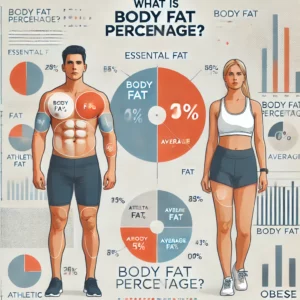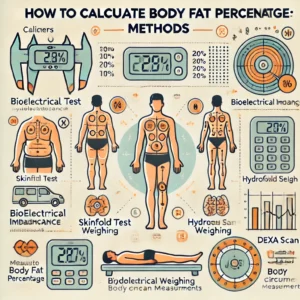Calculating body fat percentage is one of the most effective ways to assess your overall health and fitness, yet many people rely solely on weight. While body weight is an important measure, it doesn’t give you a complete picture of your body composition. Knowing your body fat percentage can provide insights into how much fat you carry versus lean mass, making it a more accurate gauge of fitness and health.
In this guide, we’ll walk you through the different methods to calculate body fat percentage, provide a simple formula, and explain what those numbers really mean.
What is Body Fat Percentage?

Body fat percentage is the proportion of your body weight that comes from fat. This is different from body mass index (BMI), which doesn’t account for muscle mass. Body fat percentage is a better indicator of fitness, since it reflects the actual amount of fat in your body.
For example, two people who weigh the same might have very different body fat percentages. A lower body fat percentage is typically associated with better health, higher fitness levels, and greater athletic performance.
How to Calculate Body Fat Percentage: Methods

There are several ways to calculate body fat percentage, ranging from simple at-home methods to more accurate clinical tests. Let’s take a look at some of the most popular methods.
1. Skinfold Calipers (Pinch Test)
Skinfold calipers are used to measure the thickness of skinfolds at various sites on your body. The measurements are then used in a formula to estimate your body fat percentage.
Step-by-Step:
- Use the calipers to measure skinfolds at sites like the triceps, abdomen, and thigh.
- Add the measurements together and use a body fat percentage formula (like the Jackson-Pollock formula) to calculate your estimate.
Pros: Low-cost, fairly accurate with practice. Cons: Requires proper technique to ensure accuracy.
2. Bioelectrical Impedance Scales
Bioelectrical impedance scales work by sending a small electrical current through your body and measuring the resistance. Lean tissue conducts electricity well, while fat is a poor conductor, so the device estimates body fat based on resistance.
Step-by-Step:
- Step on a bioelectrical impedance scale.
- The scale will provide an estimate of your body fat percentage.
Pros: Quick and easy to use. Cons: Accuracy can be affected by hydration levels and other factors.
3. DEXA Scan (Dual-Energy X-ray Absorptiometry)
The DEXA scan is one of the most accurate methods for measuring body fat percentage. It uses X-ray technology to measure bone, lean tissue, and fat mass. A DEXA scan can also provide a detailed breakdown of fat distribution across the body.
Step-by-Step:
- Undergo the scan at a medical facility or clinic.
- The results will give you a precise body fat percentage and fat distribution.
Pros: Extremely accurate and detailed. Cons: Expensive and not as accessible.
4. Hydrostatic Weighing (Underwater Weighing)
This method involves being submerged in water, and your body fat percentage is calculated based on how much water you displace. The more fat you have, the less you weigh in water.
Step-by-Step:
- Sit on a scale underwater and fully exhale.
- The scale will measure the displacement of water to calculate body fat percentage.
Pros: Very accurate. Cons: Not widely available, uncomfortable for some people.
How to Calculate Body Fat Percentage Using a Formula
If you’re using the skinfold method, you can calculate your body fat percentage by following a formula that accounts for measurements taken at various points on your body. For instance, the Jackson-Pollock formula is one of the most commonly used.
For men, the formula is: Body Fat % = 495 / (1.29579 – 0.35004 * log(sum of skinfolds)) – 450
For women, the formula is: Body Fat % = 495 / (1.0324 – 0.19077 * log(sum of skinfolds)) – 450
This method requires proper skinfold measurements and familiarity with the formulas.
What Do Your Body Fat Percentage Numbers Mean?
Your body fat percentage can help you determine where you fall on the fitness spectrum. Here’s a breakdown of the typical body fat percentage ranges:
For Men:
- Essential Fat: 2-5%
- Athletes: 6-13%
- Fitness: 14-17%
- Average: 18-24%
- Obese: 25%+
For Women:
- Essential Fat: 10-13%
- Athletes: 14-20%
- Fitness: 21-24%
- Average: 25-31%
- Obese: 32%+
Knowing where you stand within these ranges can help guide your fitness goals and overall health strategy. It’s important to remember that body fat percentage is just one metric in a broader picture of health.
Tips for Accurate Body Fat Measurements
- Take measurements consistently: Perform measurements at the same time of day, preferably in the morning, and avoid eating or drinking right before testing.
- Use the same method: If you’re using calipers or a scale, try to stick with the same method over time to track changes more accurately.
- Consider multiple methods: Combining a few different methods (e.g., bioelectrical impedance and skinfold measurements) can give you a better overall estimate.
Conclusion
Knowing how to calculate body fat percentage is an important step in understanding your body composition and setting realistic health and fitness goals. Whether you use skinfold calipers, a bioelectrical impedance scale, or a DEXA scan, measuring your body fat percentage can give you valuable insights that you might not get from a standard weight scale alone.
By monitoring your body fat percentage over time, you can track your progress and make adjustments to your diet and fitness routine as needed. Remember, it’s about improving health, not just the number on the scale!
Check out our Body Fat Percentage Calculator


